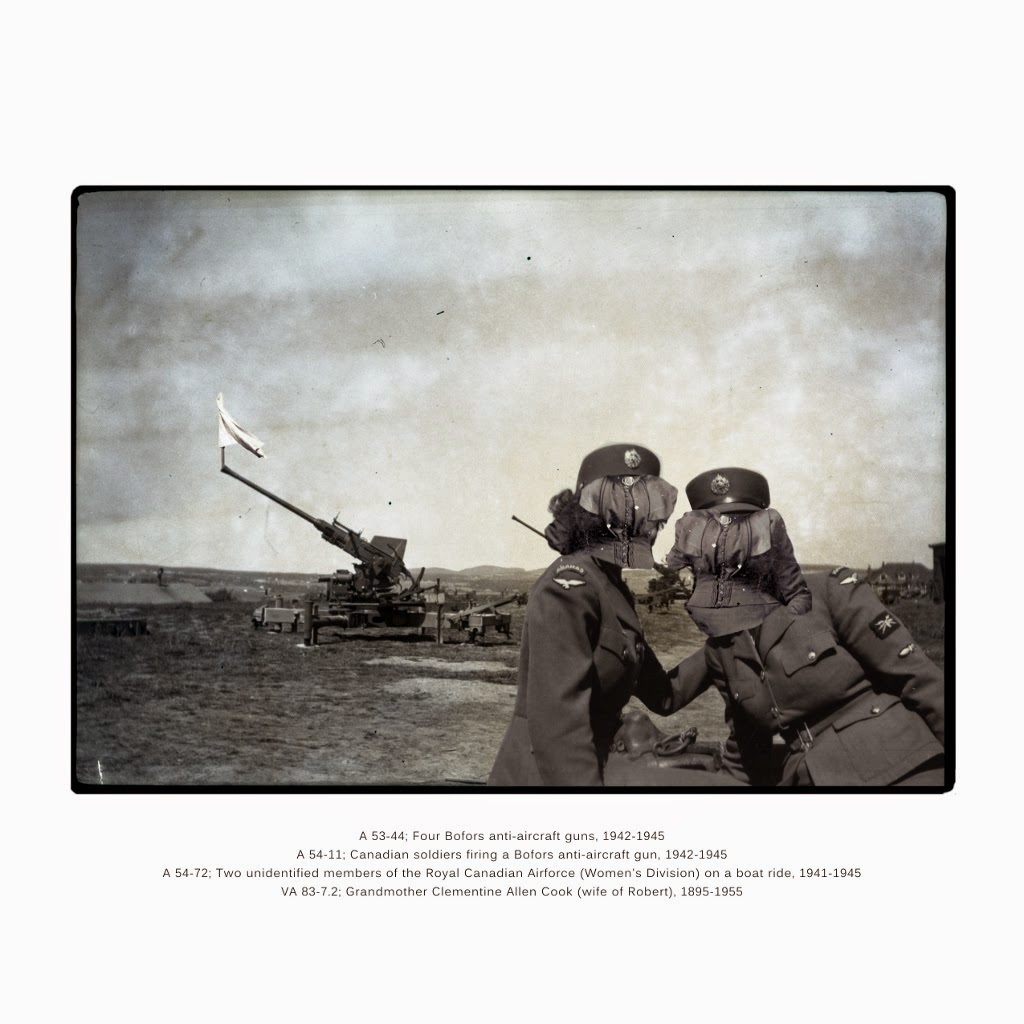The project Collage Series / Women of Newfoundland & Labrador during the First and Second World Wars, started with an invitation from Mme Vicky Chainey Gagnon, Director Chief Curator of The Rooms Provincial Art Gallery Division, to travel to St-John's, NL, to make a research residency - on Newfoundland & Labrador Women at work during the First and Second World Wars - at The Rooms in the Archives Division. During the two weeks residency in august 2014, I carefully selected archived images to realize a series of 40 collages – from which 32 are presented at The Rooms in the Vitrines on Level 2, from January 15th until September 13th 2015.
Within
the framework of this project I investigated the concept of collage
along two principal axis in order to precise an aesthetic and
procedural approach.
The
first axis is related to the mechanical act of tearing asunder –
i.e. the act of sampling – that is used in the collage process, no
matter the medium, or even art discipline1.
Then comes the act of rethinking and recomposing the images to
generate a new narrative (a new whole).
Since
I was working with archived documents
- already scanned by the Archives Division staff - the second axis is
more related to notions of realism and supposedly objective visual
culture, to question the
notion of authenticity of historical archives in this Ubiquitous
Computing/Media world we now live in.
This brought me to work with digital format, using software tools to
reach the blending quality that I was looking for. Since the archived
photographs
all come from different types of equipments, dates, and stills, a
great deal of effort is invested into creating an aesthetically
coherent combination of images of different sources. First,
for each collage, I selected a background - or environment-like
images - in most cases they were pictures of landscape - taken during
either between 1914 and 1918 or between 1939 and 1945. The selected
background became the starting point of the collage's construction
and composition. The other elements that I selected, extracted and
recontextualized had to be modified to match the color spectrum and
the grain of the background picture, so that the quality of the
foreground image was not alien to the background, for the act of
collage and combination can be more subtle. This blending approach
comes from the intention to make a new image (which is a false
reality) that seems as real, or as credible, as the original, in
order to question notions of authenticity and evoke the role of
remembering through storytelling.
Although
the material used for the collages are of a documentary nature, the
treatment of the photographic document is not. It can sometimes have
the look of a documentary photography, but it is totally constructed.
Since most of the reconstructed document respects notions and markers
of realism, it may induce ethical problems. That is to say the
problem of falsifying reality.
Indeed,
most of my collages give a result that is not necessarily looking as
a collage at the first glimpse. This is one precise aesthetic moment
that I was looking for in this project. Indeed, at this specific
short time, there is a collapse between the fake and the apparently
real, where our brains and minds have to spend some time to figure
out the limits of the collage, its veracity, its ability to cheat
reality. This opens many poetical and aesthetic potentials.
This
also reminds some parts of my former interest in narration. But this
time, the narration is actualized in a real historical framework
instead of being inscribed in a purely fictitious and poetic lineage.
Here, the narration is more similar to notions of transmission and
interpretation of history, maybe as in the case of storytelling. Of
course, the actual story is somehow visually told, but also bent and
transformed by its complex mythological charge – such as in
primitive civilizations where knowledge was orally transmitted but
also charged with metaphorical content. Such as eschatology and
cosmogony myths marking a transition of an age to another – i.e.
the end of life as we know it and the beginning of a new age.
However,
here, this is done with great care: I mean without the intention to
tend toward a literal and factual history, or even to fall in the
trap of the “grand narrative” discourses. This new research and
creation project proposes a mythical and narrative constellation
anchored in the visual and photographic iconography of that time but
without grand narrative or teleological interpretation.
The
acts of digital collage and cut-out operate, in themselves, like
metaphorical and procedural representations of the despoliation that
occurs during war times, and the lives torn in the context of these
strong cultural tensions and social transitions. Transitions that
were also aligned with a new phase of industrial modernity.
Transitions accelerated by technological advances, both industrial
and logistical, perfectly representative of the economical and
political contexts created by these wars, that literally remodeled
the workers' – both men and women - work culture.
Also
informed of the most recent writings on cultural heritage in the
digital revolution, this new project also plays with, and questions,
the place and the culture of museums and archival institutions. Two
institutional models that have to redefine and reposition themselves
in this digitally-altered historical information-base in
relation with the new generation (Cameron et Kenderdine, 2010)2.
1-
For example, the well known cut-up technique that William S.
Burroughs translated from literature to sound (taped cut-ups), film
and mixed media experiments.
2-
Cameron F., Kenderdine, S. (Éd.) (2010), Theorizing Digital
Cultural Heritage, Cambridge,
MIT Press.














No comments:
Post a Comment